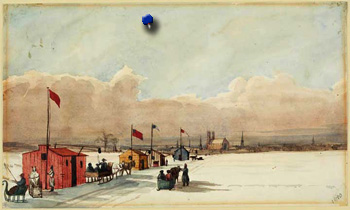La Prairie, 1840's.

from Montréal to La Prairie, 1840
No bridges crossed the Saint-Lawrence river consequently trade relied on boats to connect the city with towns on the opposite banks. The long docks extending out from LaPrairie beckoned with a good port and roads to move goods. In the winter the frozen river formed an ice bridge between the two cities. Halfway houses were set on runners and pulled into position. Travelers could stop and "refresh themselves" as they traversed between the two towns.
Steamers had been docking there since 1808 making it only natural the village was chosen as the terminus for the first public railway in Canada. The Champlain & St. Lawrence Railway began operations on 21 July 1836 with an inaugural run along its wooden rails to Saint-Jean-sur-Richelieu 16 miles away. Governor Lord Gosford and 300 other guests took the short ride in the train pulled by a locomotive named Dorchester. The town thrived in the wake of this new development.
Fire and Water.
The arrival of the train was a boon to the local economy, but came with a horrible price. On 4 April 1846 a firebrand fell from the furnace of the Champlain & Saint Lawrence Railway's steam locomotive lighting a blaze. The fire consumed most of the village, about 400 buildings, and ended the lives of several of the citizens. There was more to come.
The fire and the flood were severe blows but the final punch was delivered by the completion of the Victoria Jubilee Bridge in 1860 connecting Montréal to Saint-Lambert. LaPrairie, after being decimated by disaster, was bypassed by progress.
- https://www.ville.laprairie.qc.ca/la-ville.php?ville=1
- Image: Library and Archives Canada, Acc. No. R9266-531 Peter Winkworth Collection of Canadiana; Half way Houses on the Ice Road from Montreal to La. Prairie, 29th Feb. / 1840
